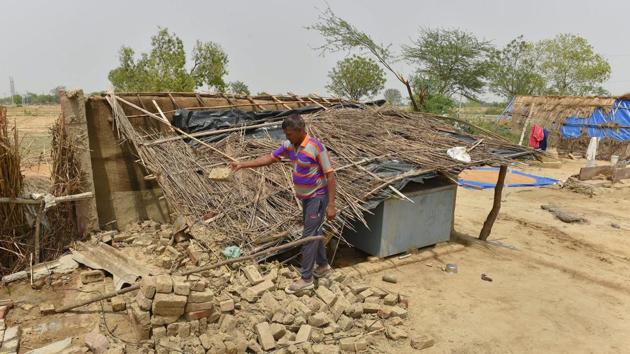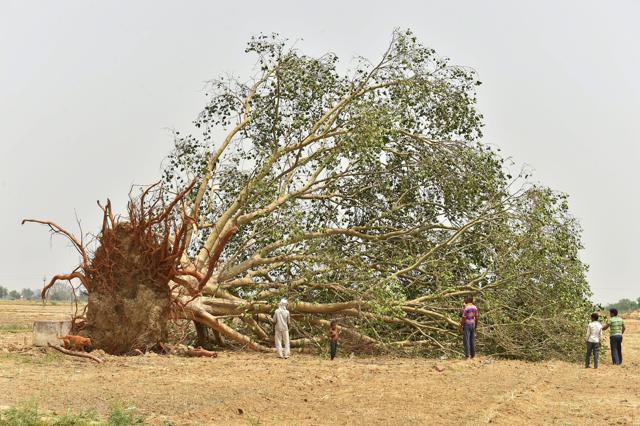Warning issued, but did not reach all those at risk, says MeT department
State agencies, however, said the alerts were not specific enough while experts rued that the forecasters did not foresee the severity of the deadly weather phenomenon.
Warnings of the chain of thunderstorms that claimed 125 lives were issued at least three days before the freak weather phenomenon wreaked havoc across six Indian states, officials from the India Meteorological Department (IMD) said on Friday.

State agencies, however, said the alerts were not specific enough while experts rued that the forecasters did not foresee the severity of the deadly weather phenomenon.
What wasn’t flagged, however, was the intensity and the unusually widespread nature of the storms, the officials added. That, coupled with poor dissemination of information to those who were likely to be affected led to widespread damage and took a huge toll on human lives in Uttar Pradesh and Rajasthan.
“We issued warnings on April 29, 30 and May 1,” KJ Ramesh, director general of the IMD, said. “These include colour-coded maps based on the severity and likely duration of the storms.”
The dispatches and warnings are shared with the disaster management authorities and local officials as well, according to Ramesh. However, the information did not reach all the vulnerable people, he said.
“We are working on improving the public dissemination,” he added.
But experts and other weather officials said that the severity and range of the storms was underestimated by the forecasters.
“Does IMD’s responsibility end with telling the district administration? By putting it on the website and messaging officials? If you are issuing warnings why don’t you have a warning dissemination system in place?” asked Piyoosh Rautela, a Dehradun-based disaster management expert.
“If you communicate general information about a region, how will a person know what is going to happen in their area? Unless you are specific about space, time and magnitude, the information is not useful,” Rautela added.

The UP government raised the issue of non-availability of accurate alerts from the meteorological department on the dust storm that hit the state on Wednesday at a meeting of the National Disaster Management Authority (NDMA) in Delhi on Friday. Relief commissioner Sanjay Kumar told NDMA officers that the state should have been given pin-pointed alerts regarding the storm so that an effective mitigation mechanism could have been put in place to minimise the loss of life and property.
Thunderstorms are a regular feature of the pre-monsoon season in India, but their intensity and frequency is likely to increase with a changing climate, studies show.
The IMD also provides nowcasts that are issued about the progress of storms every two to three hours.
People living in mud houses with thatched roofs were the most badly affected as storms packing wind speeds of up to 130km per hour cut a swathe through six states -- Uttar Pradesh, Rajasthan, Uttarakhand, Madhya Pradesh, Punjab and Haryana.
The storms were blamed by experts on a confluence of three weather factors - a cyclonic circulation, induced by a western atmospheric disturbance, high moisture levels brought by easterly winds and a recent spell of unusually high temperatures that soared to 45 degrees Celsius. The result was a squall line or a chain of thunderstorm clouds that emerged on Wednesday afternoon from north Rajasthan to eastern Uttar Pradesh, passing over Delhi as well.
“We are trying to improve communication, not just to officials but also people in a structured manner, and also the modelling to improve predictions,” M Rajeevan, secretary, ministry of earth sciences, said.
Apart from its weather stations, IMD relies on satellite data from Indian Space Research Organisation (Isro) to track weather events and possible disasters. “We’re only responsible for providing the data, analysing it and coming up with predictions is IMD’s role and the accuracy depends on how good their modelling is,” said an Isro official who asked not to be named.
Prime Minister Narendra Modi approved ex-gratia relief of ₹2 lakh each for the next of kin of those killed in the dust storm on Wednesday. The assistance will be provided from the Prime Minister’s National Relief Fund. The PM also approved ₹50,000 each for those seriously injured due to the storm, a statement from the PMO said.






